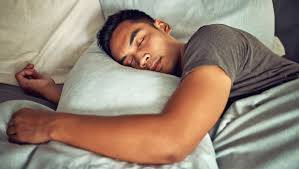When you think about it, sleep is incredibly weird. We spend about a third of our lives completely unconscious - more time than we dedicate to literally anything else. It's the number one activity amongst humans, yet it involves lying motionless in a dark room, oblivious to the world.
Stranger still is the nonsense our brains conjure up whilst we slumber. We experience bizarre visions and scenarios featuring giant parakeets with celebrity faces and the like. But as odd as sleep is, practically no one dislikes it. In fact, we’re all addicted, welcoming the oblivion of slumber with open arms each night.
For those with sleep disorders however, bedtime can be terrifying. Sufferers of conditions like narcolepsy, sleepwalking, and nocturnal eating endure all kinds of weird and worrying symptoms. But perhaps the strangest and most frightening disorder is sleep paralysis.
What Exactly is Sleep Paralysis?
Whilst falling asleep or waking up, around 50% of people will at some point experience sleep paralysis. This involves a temporary paralysis of the body whilst remaining fully conscious. It often lasts just seconds but can persist for several terrifying minutes, leaving sufferers fully aware but unable to move a muscle.
This paralysis alone is disturbing enough, but that's just the start. Most people also endure a variety of additional symptoms, from numbness and tingling to auditory hallucinations. But the really nasty effects centre around visual hallucinations and an overriding sense of fear.
Around 75% of cases involve seeing threatening figures in the room, often sitting or lying upon the paralyzed individual. Sufferers report goblin-like creatures, old hags with claws, and most famously, sinister shadowy figures resembling demons. These entities terrify those afflicted, with many sensing an evil presence or even a sexual assault at the hands of these imagined fiends.
Of course with today’s scientific knowledge, we don’t ascribe these nocturnal torments to demons and spirits as our ancestors once did. But medical understanding of sleep paralysis remains limited. What we do know is it appears to arise from issues transitioning between sleeping and waking states.
The Leading Theory Behind Sleep Paralysis
Whilst dreaming, we undergo temporary paralysis through ‘REM atonia’, preventing us from acting out vivid dream activity. Current thinking suggests sleep paralysis occurs when this paralysis happens at the wrong time - coming on too early whilst falling asleep or wearing off too late when waking. This explains the primary symptom - being unable to move.
But what about the dark hallucinatory figures that often accompany sleep paralysis episodes? This is trickier to account for scientifically. One idea is that sufferers are in a transitional phase, simultaneously conscious yet dreaming. So imagination bleeds into reality, conjuring up visions of goblins and demons.
An instinctive panic response to paralysis may also generate fearful imagery. Finding yourself suddenly paralyzed triggers your brain’s hypervigilance mechanisms that scan for threats. But tucked safely in bed, no real dangers exist. So your mind fills in the blanks by fabricating menacing intruders like demons sitting on your chest.
Why Hallucinations Are So Consistent
Interestingly, these hallucinatory figures tend to be eerily similar across cultures and throughout history. From ancient Egyptian Jinn to the more modern ‘shadow people’, most cultures interpret these visions as evil spirits or demons.
Part of this consistency likely stems from typical physiological responses. The shallow breathing of REM sleep can create chest pressure - imagined as a demonic presence crushing the paralyzed sleeper. Failing to overcome this perceived attack breeds more acute dread.
So despite huge variety in cultural myths and imagery, the innate bodily reactions we all share provoke common threatening interpretations - of demons, hags and goblins.
Triggers and Treatments
In terms of triggers for sleep paralysis, contributing factors include: stress, irregular sleep, sleeping on your back, insomnia, sleep apnea and possibly genetic predisposition. Whilst ultimately harmless, episodes can be horrific. But some basic steps can help limit attacks.
Getting sufficient regular good quality sleep is key. Stress management also helps by inhibiting anxious physiological responses. If paralyzed, trying to relax and remain calm rather than panic can also shorten episodes. And attempting to wiggle fingers and toes can terminate paralysis more quickly. Beyond this, tolerance and realization that despite appearances, nothing can actually harm you during episodes can help sufferers overcome sleep paralysis.
So next time you wake up frozen and shocked to find a sex pest demon crushing your chest, try not to panic! The ordeal, however vivid and terrifying, remains only temporary illusion. Keep calm, relax, and before you know it, your unwelcome guest will vanish back into dreamland.


